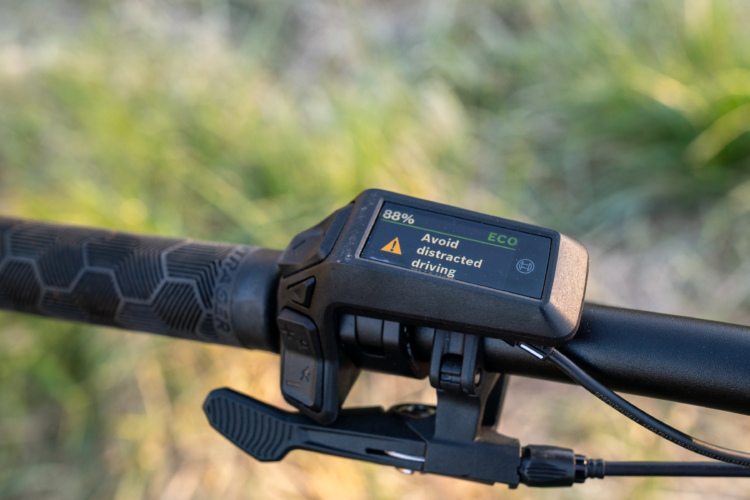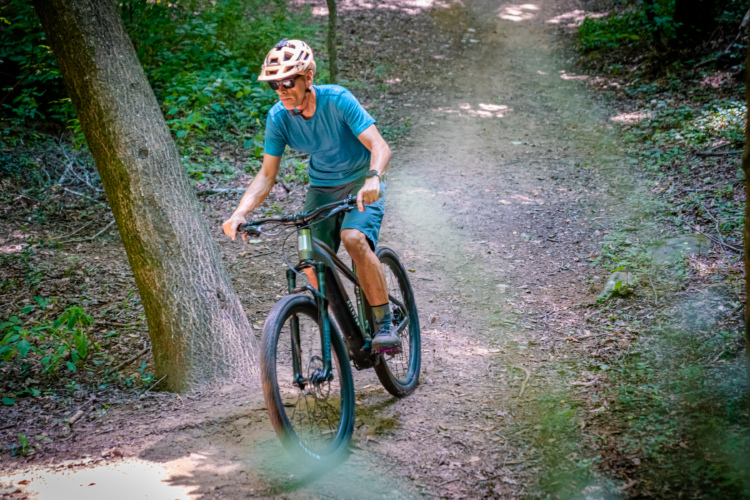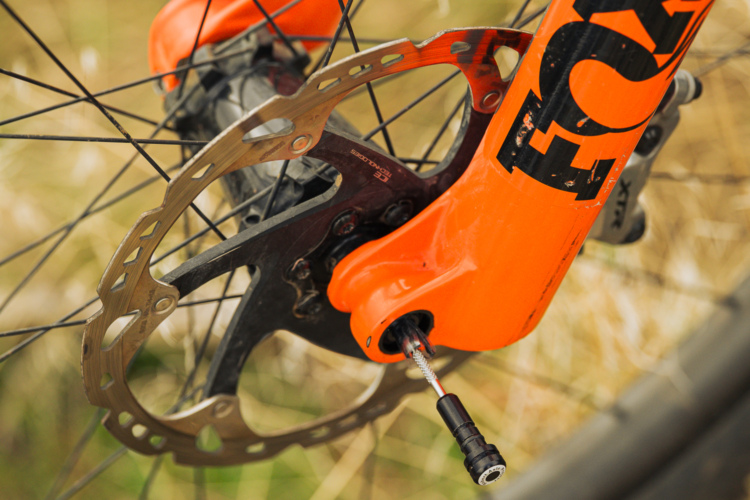
News of the Bimotal Elevate e-bike conversion system first came across my desk in 2020 among a tsunami of pre-Sea Otter press releases. Now, four years later, the company is generating buzz among early adopters and some of our readers with the innovative $1,995 system that turns almost any mountain bike into an e-bike — and back again — at the flick of a quick-release lever. In this article, I’ll cover the key specs, installation, and (briefly) how the Elevate performs on the trail.
Overview
How does it work?
The Bimotal Elevate system consists of a battery, motor, and bar-mounted controller, along with a brake mount adapter and a gear attached to a disc brake rotor. The motor is mounted to the bike’s frame using an adapter that fits onto the disc brake mounts, so buyers can run their existing brake caliper. Bimotal says they have adapters to fit 50-60% of the mountain bikes on the market, with plans to eventually offer adapters to fit pretty much any disc-compatible bike.
In its current form, the Bimotal Elevate is essentially a class 2 e-bike system that’s throttle activated. The company notes on their website, “Elevate systems purchased today will be compatible with pedal assist after a future firmware update and purchase of the sensor in development.” My test system is using a prototype push-style remote that turns the motor on and off, and the motor has a stated maximum speed of 20mph.
Bimotal plans to roll out class 1 capabilities in two phases, the first being what the company calls “compliance pedal assist.” This will add a cadence sensor, so the motor only delivers power if the rider is pedaling. Phase two, which is far more technically challenging, involves adding a wireless strain-based sensor that works similarly to a power meter. Except, it has to be way faster than any power meter that is on the market.
“Those all do about eight to 10 hertz, and that’s not fast enough,” Bimotal founder Toby Ricco told me. “You need 100 hertz to 1,000 hertz” to deliver pedal assist that’s responsive and feels natural.

Why does it exist?
Ricco was working for Tesla in the car company’s powertrain division when he first got the idea for a better e-bike retrofit kit. After suffering a knee injury, he found he couldn’t bike uphill without severe pain, leaving his beloved Cannondale Jekyll to gather dust.
“I was like, OK, I want to add a motor to this bike,” he said. All the e-bike conversion kits he found online were either cumbersome, under-powered, or difficult to install, so he came up with the idea of a compact system that drives the rear wheel using the brake rotor. Ricco notes “there’s a lot of torque going through that brake,” and initial prototypes simply carved teeth into a standard rotor, effectively turning it into a cog for the motor to drive.
Ricco and business partner Neil Flock tell me that converting a favorite mountain bike is just one of the reasons customers are interested in the Elevate system. Electrified versions of specialty bikes like tandems and gearbox-driven bikes have been slow to market, leaving customers few, if any, options. Then there are buyers who already own a $5,000 bike and aren’t able to spend another $5,000 or more for an electric bike but are willing to invest a couple thousand dollars in the Bimotal Elevate to keep up with friends who ride electric. For still others, a dual-purpose bike saves precious space in the garage or apartment, or it’s a way to share a single battery and motor among a fleet of traditional bikes they already own.
A less obvious argument for an e-bike retrofit kit, but perhaps a more interesting one, is that it allows riders to adapt their bike to various trail use regulations. Because the Bimotal Elevate can be removed in under a minute without the need for tools, buyers can choose to ride electric on some trails and mechanical on others.
The Bimotal team has put years of design and engineering work into the product, which didn’t actually begin shipping until March of this year. “It’s been probably the most challenging technical undertaking I’ve seen in my career,” Ricco said. “It’s been quite the ride.”
Bimotal Elevate key specs
- Turns compatible mountain bikes into a Class 2 e-bike; future update promises Class 1 functionality
- Motor: 750W, 20mph max speed
- Battery: 302.4Wh capacity
- Weights: 1.51kg motor, 1.59kg battery, 3.98kg overall, including mounting hardware, controls, and wiring
- Price: $1,995
- Buy from Bimotal


Installation
The Bimotal Elevate is a product that succeeds or fails based on how compatible it is, and how easy it is to install. After all, there are plenty of complete eMTBs that offer similar or better performance specs, but they’re fixed systems, and they can’t turn your current bike into an e-bike. I’ll also add that it’s not just the installation that matters here; the Elevate also needs to deliver on its promise of being quick and easy to remove, too.
I chose to install the Elevate system on my aluminum alloy Canyon Neuron trail bike, which is a pretty standard trail bike.
Bimotal provides a well-written and professionally-illustrated 35-page installation guide online, which I followed to set up my test unit. Flock tells me most buyers choose to install the system themselves at home, though Bimotal plans to certify professional installers for those who would rather leave it to the pros.
Given different brake mount standards, it’s important to select the proper Bimotal mount hardware. I was able to consult directly with Flock and Ricco, and while their website does a good job helping buyers determine which adapter is needed, choosing the right adapter is probably the trickiest part of the process.
All the necessary hardware, including bolts and even zip ties, is included in the box. The instructions note that threadlocker should be used on pretty much every bolt, so be sure to have some on hand. This is particularly important so that bolts don’t work themselves loose due to vibration from the motor.
I needed to adjust the angle of my brake hose to get the caliper to sit just right inside the adapter, and luckily I found that my hose was just long enough to make everything work. For some, installation might require installing a longer brake hose. Installing the rotor is straightforward, and I highly recommend bedding in the new rotor with your existing pads before going out for a trail ride, or even better, throwing in a fresh set of pads and bedding them in as a part of the installation.

I had a hard time getting the quick-release mounts on the motor dialed in just right; they were often either too tight, or too loose. I eventually found the sweet spot, though there were still times I needed to break out my 4mm hex wrench to remove or reattach the motor.



Attaching all the wires and cables can be as neat or as ugly as you like, depending on your level of OCD. The battery mounting bracket attaches to a standard set of bottle mounts and the included Velcro strap holds the battery securely.
Overall, the Bimotal Elevate system is much more refined than I expected it to be, both in terms of how it looks and how everything fits together. The installation instructions are excellent, and the system works exactly as promised. Parts are sourced from around the globe, from Taiwan to Germany, and everything is assembled and tested at the company’s facility in California.

On the trail
I’ve tested dozens of class 1 electric mountain bikes over the years, but this is the first class 2 bike I’ve spent any significant time riding. Whereas class 1 bikes are designed to give the rider a natural feeling that’s similar to pedaling a regular, non-electric bike, class 2 bikes are more akin to throttle-based motorcycles.
The Bimotal Elevate delivers good acceleration from a stop whether you choose to pedal or not. Pedaling definitely adds more power, more quickly, which I found to be helpful when navigating more technical trail sections. If you want to, you can use the motor to shuttle you straight uphill without having to pedal at all, though obviously, this is a big drain on battery life and risks overtaxing the motor.
In my tests I found the Elevate maxes out at about 19mph, just shy of the 20mph legal limit. I’ve experienced the same with other e-bikes too, though I do wonder if the motor is calibrated based on wheel size, or if it’s possible to get more speed using a smaller-diameter wheel.
One drag I experienced while testing the Bimotal Elevate was, well, pedal drag. With the motor powered on, there’s a noticeable amount of resistance when pedaling under 100% human power. On their website, Bimotal says, “Elevate has a freewheel clutch that is silent and completely drag free” when the motor is off. However, I can still feel some drag with the motor turned off. I thought this might be because the gear mesh was too tight on my setup, so I added more spacers to the motor mount stack, but I still felt the same resistance from the un-powered motor.
Flock tells me the Bimotal motor features an internal sprag clutch that doesn’t add resistance to coasting. However, the bearing seals do add some friction, and that’s likely what I was feeling.
With the bearing seal drag and added overall weight of the system, the result is a bike that is harder to pedal without assistance than a non-electric bike. With the motor completely removed from the bike, it pedals like normal.
Almost every electric mountain bike emits a telltale high-pitched whine, and some are louder than others. The Bimotal Elevate whines a little and also rumbles. Here again, I thought maybe the gear mesh was too tight, but even with extra spacers, the system still produces a distinctive buzzing sound. After consulting with Flock and Ricco, I learned it’s normal to hear and feel some vibration when the motor is powered and engaged.
I rode on some particularly technical, off-camber trails with the Elevate, and I felt like I struggled more than usual. I suspect the three-pound-plus motor hanging off the left side of the bike had me a little off balance, and modulating the power from the motor likely takes more practice to operate smoothly.
The Bimotal Elevate system doesn’t include a display, though an app is in the works that promises to show battery capacity among other things. For now, Bimotal notes in a FAQ that buyers will want to get a feel for battery range based on their own usage and then track distance and elevation to estimate how much battery life remains. Since the system is modular, one could easily purchase an additional battery or two for extended range.

Where does it fit?
The Bimotal Elevate e-bike conversion system is unlike anything else on the market, and for now it’s a niche product in the mountain bike world, given its class 2 limitations. Most eMTB designs require brands to build their frames around a specific motor, and one that can’t be moved from bike to bike, unlike say a wireless dropper post or a set of wheels. But it’s possible that could change in the future if manufacturers were to standardize motor mounts, in which case Bimotal could be positioned as an early mover. In fact, Ricco and his team spent the previous two years developing a more traditional mid-drive system with great specs, only to have the project’s plug pulled by an unnamed sponsor.
“The specs are wild,” Ricco told me. “And we still have that. We have functional prototypes.”
There’s still some work to be done with the Elevate, and additional opportunities to pursue. It’s clear the Bimotal team recognizes this and has plans to keep improving and expanding their capabilities, one bike conversion at a time.





















12 Comments
Nov 14, 2024
Nov 14, 2024
Nov 17, 2024
Nov 14, 2024
Nov 14, 2024
Nov 14, 2024
But using it on singletrack? Maybe not so much...
Nov 24, 2024
Nov 14, 2024
Dec 10, 2024
Feb 8, 2025
We are looking at different battery cell chemistries to boost range in the future, but for now we are using the same cells that most other ebike systems use. As an aftermarket system, we have limited space available as our battery has to fit around rear suspension shocks, linkages, and frame members (we can't stuff a battery into the down tube). Our battery has an impressive amount of energy for the space available and is small and easy to carry, so you can bring as many batteries as you need for a given ride.
Battery consumption will be similar when riding with people on production ebikes. For comparison, our battery has about the same amount of energy as the Specialized Levo SL or Trek EXe. The "full power" ebikes have larger batteries that have 2 - 2 1/2 times as much energy as ours, so you would be able to get through most rides carrying one extra battery in your hip pack or backpack and would get into a 3rd Elevate battery when doing rides that fully drain those large production ebike batteries.
Nov 17, 2024
Nov 21, 2024